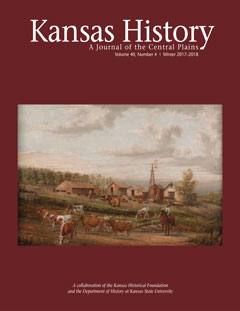February 13, 2018
Winter issue of Kansas History: A Journal of the Central Plains just released

Kansas History: A Journal of the Central Plains is published quarterly through a partnership between the Kansas Historical Foundation and the history department at Kansas State University. The Kansas Historical Foundation serves as a fundraising, fund management, membership and retail organization to support and promote the Kansas Historical Society, a state agency that safeguards and shares the state’s history through the collection, preservation, and interpretation of its past.
The history department at K-State is especially well-suited to the study of Kansas and agricultural and environmental history. As a land-grant school whose culture and economy have historically been shaped by the economy in the state, the history of Kansas holds a venerable place in the academic offerings of the university.
The journal publishes peer-reviewed scholarly articles, edited documents, and other materials that contribute to an understanding of the history and cultural heritage of Kansas and the Central Plains. Political, social, intellectual, cultural, economic and institutional histories are welcome, as are biographical and historiographical interpretations and studies of archaeology, the built environment and material culture. Articles emphasizing visual documentation, exceptional reminiscences, and autobiographical writings are also considered
for publication.
The following are three articles form the winter issue:
David Ress, "Dr. Craft and Justice Kingman: Defining the Right to Challenge Government in Gilded Age Kansas." Ress, a journalist and historian, argues that at issue in Rufus S. Craft's 1860s legal skirmish with the Jackson County commission were two different views about the relationship of individuals and government. The one, Craft's, rooted in a traditional republican vision of civic duties and civic virtue; the other, Kansas Supreme Court Chief Justice Samuel A. Kingman's, distrusted claims of an individual's special right to speak for a community in a representative democracy. Craft, in a sense, exemplified the Mugwump and Muckraker sensibility; Justice Kingman was a stand in for the reformers of the much later "short ballot" and city manager movements. Craft claimed the right to sue on behalf of everyone in the county; Justice Kingman disagreed, ruling that good public order meant it was up to voters on Election Day and, in the event of criminal misuse of public monies, officers of the state to deal with abuse of public trust. At the time Justice Kingman ruled, the standing of an individual to sue on behalf of a community was not settled law; in the decades that followed most states would say that individuals did have the right to do so.
Jay M. Price, "Dixie's Disciples: The Southern Diaspora and Religion in Wichita, Kansas." The story of evangelical religion in Wichita highlights the complicated relationship between region and religion. During the first half of the 20th century, evangelicalism transitioned from a nationwide movement to one more specifically identified with the southern Bible belt. Meanwhile, as Wichita State University professor Jay Price demonstrates, Wichita's religious demographics tended to align with those of the northern Midwest, but contained pockets of southern-leaning groups, reflective of Kansas' border state legacy. As the 20th century unfolded, southern leaning bodies such as the Southern Baptists and Pentecostals grew in number and visibility. By the 1970s, the city still reflected a largely Midwestern religious orientation but was a city in transition as Bible Belt evangelicalism was itself growing beyond its southern reputation to totally reshape American spirituality.
Bob Beatty and Linsey Moddelmog, editors, "'Find A Way To Find Common Ground': A Conversation with Former Gov. Kathleen Sebelius."The sixth piece in the special series of articles based on the gubernatorial interviews first captured on video by Washburn University political scientist Bob Beatty in 2004, this conversation with former insurance commissioner and Gov. Kathleen Sebelius explores issues such as the Anthem/Blue Cross Health Insurance provider merger, education and school finance funding, alternative energy and the proposed Holcomb coal-fired power plants, and the possibilities for Democrats and Republicans to work together in Kansas. Sebelius moved to Kansas in 1975 after marrying Gary Sebelius, and embarked on a state political career that never saw her lose an election. Sebelius rose to the governorship after serving in the Kansas House of Representatives — 1987–1995 — and two terms as Kansas insurance commissioner — 1995–2003. She was the first insurance commissioner from the Democratic Party in Kansas history and served as Kansas governor from 2003–2009, leaving office early to join President Barack Obama's cabinet as secretary of Health and Human Services. Sebelius' Kansas story is one of overcoming electoral obstacles — a Democrat in a Republican state, finding ways to bring coalitions together to get things done, and sometimes making controversial decisions, all while maintaining high job approval ratings.
